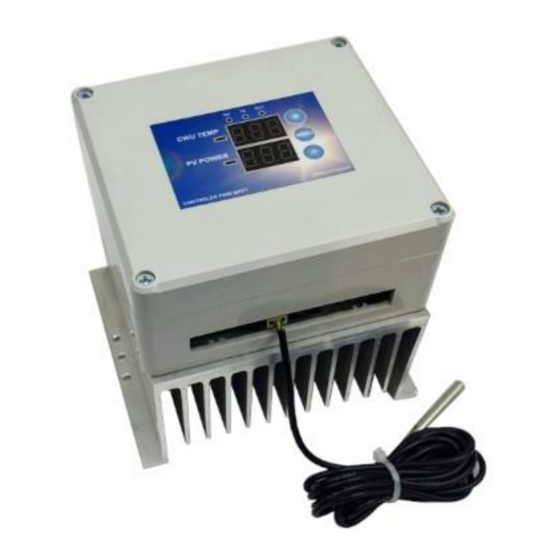
Advertisement
USER MANUAL
PWM REGULATOR OF THE HEATER POWERED
FROM SOLAR PANELS ACTii AC7392
FIRMWARE VIEW: F1.0
1. SAFETY CONSIDERATIONS
- Before starting it for the first time, please read this instruction manual.
- All connections and changes should be made with the voltage disconnected
from
panels.
the
- Proper operating
in accordance with the specification of the
conditions must be ensured,
device, such as: supply voltage, temperature, maximum current consumption.
- Installation and setting of the device require appropriate skills, so they can only be
done by qualified people, after
in full.
reading the instruction manual
- An incorrectly connected device may be damaged.
- The responsibility for the correct installation lies with the person assembling.
Make sure that you meet all the guidelines and standards in force in your
country.
- Electrostatic discharge can damage the device. Appropriate safeguards
shall
place.
be in
- It is necessary to protect the installation from discharges by disconnecting the
regulator from the panels during the storm.
- Any unauthorized alterations, modifications and attempts at repairs will void
the warranty.
- The regulator must be absolutely disconnected from the panels when we leave
the apartment for more than a day!!!
- The power plant must be equipped with fuses mounted on both wires from the
panels. It should be possible to quickly disconnect the panels in the event
a
of
failure.
Advertisement
Table of Contents

Summary of Contents for Allegro AC7392
- Page 1 USER MANUAL PWM REGULATOR OF THE HEATER POWERED FROM SOLAR PANELS ACTii AC7392 FIRMWARE VIEW: F1.0 1. SAFETY CONSIDERATIONS - Before starting it for the first time, please read this instruction manual. - All connections and changes should be made with the voltage disconnected from panels.
- Page 2 2. DESCRIPTION AND CHARACTERISTICS OF THE PRODUCT The heater regulator is used to regulate the load of the panels by changing the PWM filling factor, and in combination with the charge buffer as an active load. This allows the panels to work at the MPPT point, i.e. the largest power factor. The condition for proper operation and the highest energy yields is to ensure the appropriate load for the regulator.
- Page 3 3. INSTALLATION AND CONNECTION The device for proper operation requires proper connection. The final place of installation is the wall inside the building. The regulator should be mounted near the boiler so that there is no need to extend the temperature sensor cable. The recommended connection system of the regulator is below.
- Page 4 4.KONFIGURACJA The configuration consists in setting the set temperature to be reached by utility water. This is done by pressing the MENU button until an intermittent sound from the controller appears. Then the inscription "S.tE" appears on the top display, which means setting the set temperature.
- Page 5 The method of communication is not related to any communication protocol. In order to read the operating parameters, a query should be sent to the regulator in the form of one byte of data. Transmission parameters are: 9600 8n1. Sending one byte to the driver with the following information: ASCII 'a' (97 decimals) results in the answer: AA;...
- Page 6 RESTORE FACTORY SETTINGS To perform a factory reset, hold the MENU button when you turn on the device and hold until "dEF" appears on the top display. This feature will erase all user settings. 5. TECHNICAL DATA Secondary 11 V to 14V supply voltage Panel From 120V to 350V DC...
- Page 7 The CE symbol on the device indicates the compliance of the device with the Electromagnetic Compatibility Directive EMC 2004/108/EC (Electromagnetic Compatibility Directive). This mark on the device informs about the prohibition of placing the used device together with other waste. The equipment must be handed over to designated disposal points.

Need help?
Do you have a question about the AC7392 and is the answer not in the manual?
Questions and answers